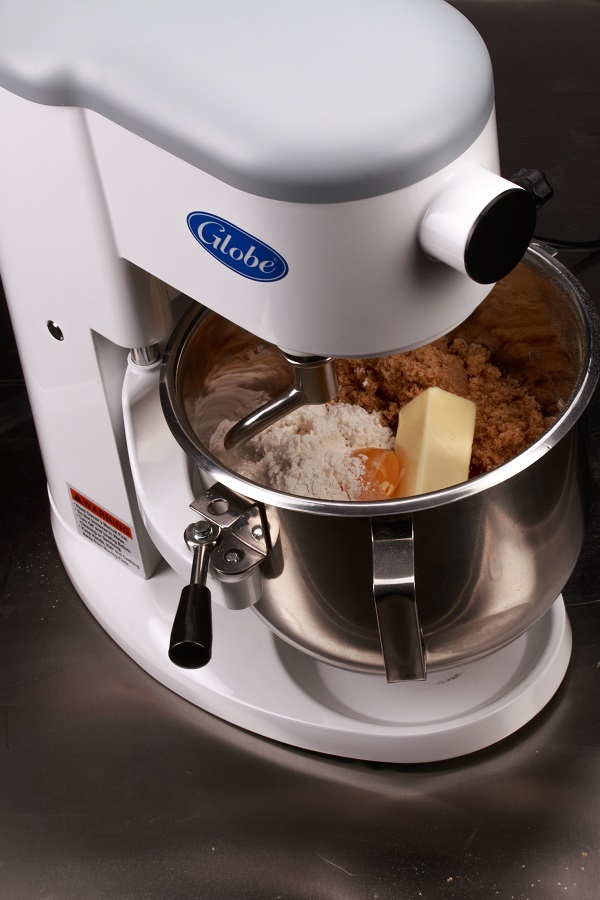A mixer is a mixer, right?
Apr 20th 2017
Not necessarily. Choosing a new mixer involves a few details you should know and consider in order to maximize your purchase.
Certainly the machine footprint, and size of the bowl are important things to consider for your mixer buying decision, yes. But, let's address mixer styles, strength of construction and capacity due to absorption of water. All of these factors make a difference in the overall cost of ownership of your new mixer.
There are many styles of mixers, but here we will showcase two of the most common types; Planetary and Spiral.
Planetary: The Merriam-Webster Dictionary states "…having or consisting of an epicyclic train of gear wheels." Translation; it moves around in a small circle while at the same time going around in a larger circle. For a visual, think Tilt-O-Whirl or The Zipper at the carnival. Primary Planetary uses: Sauces, frostings, creams, batters or other liquids. These machines are generally referred to as "mixers" as a general category and most have the ability to do small wetter batches of dough such as cookie dough. The products are blended by the mechanism moving around the bowl at varying speeds. The coverage of the mechanism makes a difference in the efficiency of the mix.
Spiral: (Merriam-Webster) "…winding around a center or pole and gradually receding from or approaching it." Primary Spiral uses: Doughs. These machines are considered a special category of mixer and are built primarily for bread, pizza, pretzel, bagel, pastry or croissant dough. The coil shaped mechanism turns while the bowl turns the opposite direction, creating a folding effect. The design of the center or pole of the bowl makes a difference in the efficiency of the mix.

What to look for in internal and external construction – Planetary
The Globe SP5, planetary mixer is a small unit with big performance. It can power through any batch of ingredients. The horsepower of the motor gives you a clue to its strength – the more horsepower the more effective the unit. It doesn't have to work so hard to get the job done. The number of speeds allows you to be flexible with your food product – some recipes require more delicate treatment of ingredients or some workers need to move quickly in a busy kitchen. More speeds give you more flexibility. For the greatest efficiency, be sure the mechanism touches every spot on the bowl during the mix, not just a handful of places repeatedly.
Belt drives vs. gear dives have long been a debate, which is better? Belt drives allow tension adjustment, easier maintenance and you can generally change speeds without having to stop the machine. Gear drives can be strong and require some maintenance, but don't allow for changing speeds without stopping the machine and starting again. Replacement gears can be costly.
Painted, powder coated or stainless steel should be a consideration based on placement of the machine in a facility and the environment in which it operates. Painted machines call into question chipping more than powder coating, and stainless steel, while generally more expensive eliminates the concern.
What to look for in internal and external construction – Spiral
Most of what you look for in a planetary mixer you also see in the spiral, with a few differences. The horsepower on spiral mixers also denotes strength, but in addition, watch for how many motors drive which components. The best mixers have two separate motors, one to drive the mechanism and one to drive the bowl.
Bowl construction is critical in dough production. Like our grandparents before us, when we "mix" dough ingredients, we FOLD it neatly upon itself. Center "blades" or "posts" that have square corners or points actually tear the fibers of the dough and prevent further absorption of water. Molded "cones" rising up from the center of the bowl facilitate the folding motion allowing the flour to absorb more water (thus creating more yield).
Water absorption is critical to an operator in dough production. It translates to greater yield, (ideally) no ice to cool the dough, more consistency, less time in the baking process and faster payback of equipment purchases. This is particularly important when sizing spiral mixers – they are measured in flour or finished dough weight in pounds, not generally in quarts. Size the equipment greater than your finished capacity to allow for the growth of your business and to not overload your mixer resulting in avoidable repairs.
Removable bowls with dolly assemblies or tilt over models are a consideration of each operation, but if the bowl does not remove, a drain in the bottom of the bowl is a must.
Explore our great selection of commercial mixers
Whether you are a commercial baker making light meringues or a pizza maker in need of a heavy dough, there is a commercial mixer model to get the job done accurately day after day. Shop our line up of counter top and floor models from trusted name brands, including Globe Food, Waring and Hobart.
Smaller units can handle a five quart capacity while larger models have a higher capacity, up to eighty quarts. These commercial mixers and their accessories are designed to meet the needs of even the most demanding commercial food service.
All of these factors make a difference in the efficiency and cost of ownership of your new mixer. Choose wisely and you will be the proud owner of a beautiful piece of equipment that will serve your establishment well for many years. Need help deciding? Give us a call at 800-972-4972. Generations of business owners have looked to Globe Equipment Co. for commercial food equipment and supplies for over 79 years!
